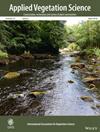Dynamics of Post-Fire Succession in Black-Water Floodplain Forests of Central Amazonia: Insights From a 36-Year Chronosequence
Abstract
Questions
Understanding the dynamics of species composition and ecosystem recovery after fire disturbance is essential for effective conservation and management strategies in the Amazon biome. This study aimed to elucidate the post-fire succession of black-water floodplain forests (termed “igapó” in Brazil) during a 36-year chronosequence, analyzing changes in density, diversity, composition, and aboveground wood biomass (AGWB) of tree species. Furthermore, we also discuss the implications of forest fires on the resilience of igapó forests.
Location
Black-water floodplain forests of the Jaú National Park and adjacent regions, Central Amazonia, Brazil.
Methods
Floristic inventories of tree species with a diameter at breast height (DBH) ≥ 5 cm were compiled in 47 plots (625 m2; total area of 2.94 ha) considering a chronosequence which integrated successional stages of nine distinct fire occurrences associated with El Niño episodes during the period 1982–2017. AGWB estimates were derived from measurements of diameter, wood density, and tree height, applying a pantropical allometric model. Changes in density, diversity, species composition, and AGWB were analyzed based on the occurrence of fires, and physicochemical soil characteristics (0–20 cm depth), obtained from each plot.
Results
A total of 3880 individuals comprising 77 tree species from 29 botanical families were recorded. The dominant families were Fabaceae, Euphorbiaceae, Rubiaceae, Malpighiaceae, Phyllanthaceae, and Lecythidaceae. Time since fire occurrence explained much of the gradual increase in species richness, diversity, density, AGWB stocks, and changes in floristic composition, while soil conditions played a minor role.
Conclusions
Black-water floodplain forests need long periods to recover after a single fire disturbance. Even after 36 years, regenerating forests exhibit lower species diversity and AGWB stocks than late-successional stages (> 100 years) of igapó forests. This reinforces the need to enhance conservation efforts to prevent fires in this vulnerable ecosystem.


 求助内容:
求助内容: 应助结果提醒方式:
应助结果提醒方式:


